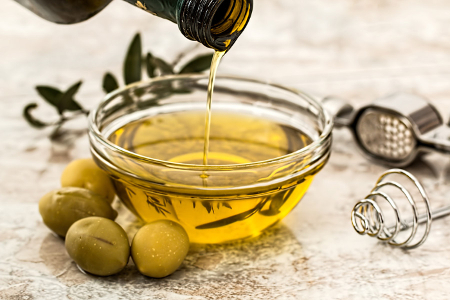
Olive is a slow growing evergreen tree with a gnarled trunk and slender gray, fissured branches. It may reach up to 50 feet in height at its natural habitat and may live for more than 500 years. It grows well under frost free dry environments assisted by well-drained, warm soil conditions.
Olive fruits are generally picked when they become plump, mature, turn light green to yellow-green, and begin to soft (veraison stage). Olives harvested at this time, contain high quantities of polyphenol and are believed to be at their best for oil extraction.
Physical characteristics of olive oil
Cold pressed olive oil from the freshly harvested berries feature light green to deep yellow depending on their maturity and veraison stage. Green olives yield greenish, bitter, and pungent oil while black fruits can be pressed to relatively less pungent, yellow oil. Fresh oil has very low free fatty acids (FFA), and natively cold-pressed oil should have less than 0.5% FFA. In general, virgin oils should have less than 0.8% FFA.
Extra-virgin is the highest grade of olive oil. As with all virgin oils, it is pressed mechanically without employing chemicals or excess heat. Its specific gravity @ 15.5 °C is 0.9150–0.9180, Iodine value-75–94, and saponification value-184–195.
Olive oil nutrition facts
• Olive oil is the best edible oil in terms of palatability, stability, lipid profile, and safety profiles.
• It is rich in energy; 100 g oil provides 884 calories. However, its high ratio of monounsaturated fatty acids to saturated fatty acids qualifies it as one of the healthiest oil for consumption.
• Extra virgin oil has a high smoke point at 450 °F (210 ºC). This property of olive is crucial while employing it in high-temperature cooking; as in deep-frying of certain food items.
• Olive oil has an excellent lipid profile. Saturated, monounsaturated, and polyunsaturated (SFA: MUFA: PUFA= 14: 77: 9) fats in it distributed in good proportions.
• Natively cold-pressed oil is one of the stable cooking oils featuring a very long shelf life.
Health benefits of olive oil
• Olive oil has distinct flavor and taste. Unlike many other oils, which are extracted from nuts and seeds, the olive is obtained from the olive berries and hence, carries large amounts of plant-derived antioxidants, phytosterols, and vitamins.
• Olive oil is recognized as one of the healthiest edible oils since it contains less saturated fats. Additionally, it composes linoleic (omega-6) and linolenic (omega-3) essential fatty acids at a recommended 8:1 ratio.
• The oil is high in calories. Its high-calorie content chiefly comes from its fats. However, it is especially rich in mono-unsaturated fatty acids (MUFA) like oleic acid (18:1) and palmitoleic acid (16:1) that help to decrease LDL or “bad cholesterol” and to increase HDL or “good cholesterol” in the blood. Research studies suggest that Mediterranean diet which is rich in monounsaturated fatty acids help to prevent coronary artery disease and strokes by favoring healthy blood lipid profile.
• Olive oil, especially extra virgin, contains tyrosol phenolic compounds such as oleuropein and oleocanthal. These compounds are responsible for its bitter, and pungent taste. Oleocanthal, oleuropein, and its derivative hydroxytyrosol are nature’s most powerful antioxidants. Together with vitamin-E and carotenoids, they play a vital role fighting against cancer, inflammation, coronary artery disease, degenerative nerve diseases, diabetes, etc.
• Studies suggest that oleocanthal has ibuprofen (NSAID) like anti-inflammatory activities. The Mediterranean diet that uses olive oil may be responsible in part for the low incidence of coronary artery disease.
• Being a vegetable source, it has very high levels of plant sterols, especially ß-sitosterol. The FDA has approved the following claim for phytosterols: “Foods containing at least 0.4 gram per serving of plant sterols, eaten twice a day with meals for a daily total intake of at least 0.8 gram, as part of a diet low in saturated fat and cholesterol, may reduce the risk of heart disease”. Phyto-sterols competitively inhibit cholesterol absorption in the gut and thereby can reduce total cholesterol levels by 10% to 15%.
• Olive oil is rich in vitamin E. 100 g fresh extra-virgin oil contains 14.39 mcg (about 96% of RDA) of alpha-tocopherol. Vitamin E is a powerful lipid soluble antioxidant, required for maintaining the integrity of cell membrane of mucosa and skin by protecting it from harmful oxygen-free radicals.
• Additionally, extra-virgin oil is also an excellent source of vitamin-K; 100 g provides about 50% of DRI. Vitamin-K has a potential role in the increase of bone mass by promoting osteotropic activity in the bone. It also has established role in the treatment of Alzheimer’s disease patients by limiting neuronal damage in the brain.
Selection and storage
In the markets, several different grades of olive oils can be displayed for sale. Buy fresh, cold-pressed oil that employed ripe greenish-yellow fruits since it is considered as the purest, highest graded oil, having superior flavor, and rich in antioxidants. Native oil extracted using traditional methods is devoid of chemicals, less acidic, has the highest smoke point, and long shelf life.
Extra virgin oil can also be cold pressed, however, using machines, without adding chemicals or excessive heat. It has acidity content of less than 0.8%. Following this are; virgin oil at 1.5%, and conventional virgin oil at less than 3%.
Pomace olive oil is refined oil obtained from the final pressings under high heat and pressure. It is inferior in quality and generally not used for cooking.
Since adulteration is quite common, check for the authenticity of the product. Look carefully for terms like “best before,” “virgin,” “native cold pressed,”…etc. Buy extra-virgin oil certified by the COOC (California Olive Oil Council) or IOC (International Olive Oil Council).
Always store olive oil in tightly sealed containers and place in a cool, dark place away from heat or light.
【Reference】https://www.nutrition-and-you.com/olive-oil.html






